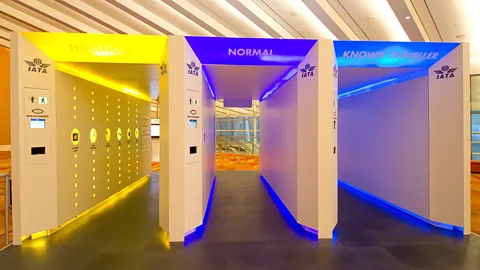
Airports in the US are trialling checkpoint systems that more adeptly balance the need for effective security, passenger privacy and efficient queues.
The TSA has been replacing those
machines with ones that use millimetre-wave
technology, which generate images that better protect passenger privacy and
rely on radio waves to check for weapons and explosives.
The TSA’s move is yet another example of
how governments across the globe struggle to provide effective security while
ensuring passenger privacy and efficient queues. As such, airports in the US are
trialling new security measures – including facial recognition
and iris scanners – to achieve
this difficult balance.
The process – also known as behaviour
detection – involves each passenger having a conversation with an officer, who
asks questions while looking for signs of fear. Passengers who act suspiciously
may be subjected to secondary screening measures, such as more invasive pat
downs. A similar experiment ran for 60 days at Boston’s Logan Airport in 2011. There’s
no word on whether this system will be deployed at other airports nationwide.
PreCheck
Since October 2011, the TSA has been testing
PreCheck, a programme in which passengers voluntarily sign up
for background checks in return for access to speedier lanes at checkpoints. Expanded
last year to 35 major US airports, including most recently San Francisco
International and Baltimore Washington, the service is open to elite loyalty
programmes members for Delta, United, American, US Airways and Alaska – the only
five airlines currently participating. PreCheck is free to frequent flyers, but
other travellers may have to pay an application fee to apply via the US Customs
and Border Protection’s trusted traveller
programs, such as Global Entry.
Critics of PreCheck say that technical
glitches, such as minor inconsistencies
in how passengers’ information is presented in various databases, often prevent
the effective functioning of the system, resulting in passenger delays. For
example, if a paper record has a passenger’s middle initial but the computer
has the passenger’s full middle name, the
system may fail to make a proper match. The TSA counters that it is working
out the kinks in the system.
At a testing centre at Dallas’ Love
Field Airport, many of IATA’s ideas are being experimented with in a prototype
checkpoint,
according to USA Today. One of the highlights is the use of next-generation
security cameras, with lenses that are sharp enough to see the faces of
passengers from far away in much sharper and more recognisable detail than the
present cameras at most US airports and can transmit those high-definition
images to hand-held devices carried by guards patrolling the airport. Currently,
guards mostly use less sophisticated cameras that only broadcast to monitors in
fixed locations. Officials at Love Field hope to deploy the improved
checkpoints within the next three years.
Unfortunately, the new systems are expensive. The TSA’s annual budget is $8
billion a year, an amount that some people deem out of proportion to the
relative threat terrorism presents.



